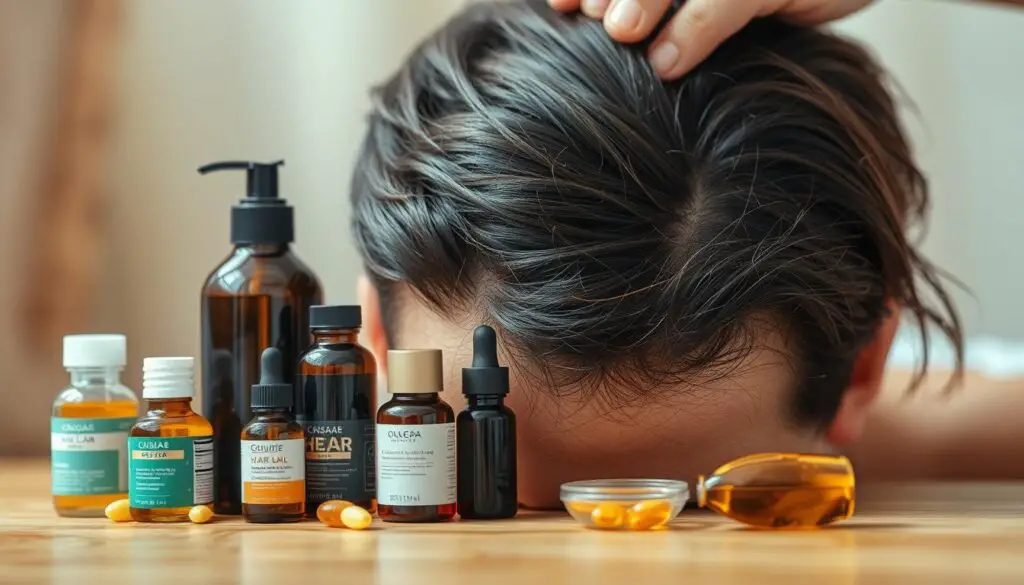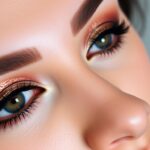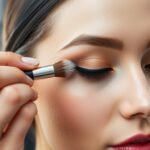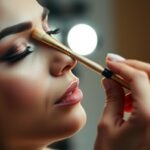Ever stared in the mirror, wishing your hair could transform from lifeless and thin to lush and vibrant? You’re not alone. Every strand of hair tells a story of growth, resilience, and potential. With the right knowledge about hair growth, you can unlock the secret to healthier, more beautiful locks.
Your scalp is home to approximately 100,000 hair follicles, each with its unique growth journey. Understanding the hair growth cycle is crucial for nurturing those strands. Most people don’t realize that hair growth involves complex biological processes that can be influenced by nutrition, lifestyle, and natural hair oil treatments.
Hair growth isn’t just about genetics—it’s about empowerment. By learning how your hair grows and what factors impact its health, you can take control of your hair’s destiny. From nutrients that strengthen follicles to techniques that boost circulation, this guide will reveal comprehensive strategies for achieving the hair you’ve always dreamed of.
Our journey will explore the intricate world of hair growth, providing actionable tips that go beyond surface-level solutions. Whether you’re battling thinning hair or simply want to enhance your hair’s natural beauty, these insights will transform your hair care approach.
Table of Contents
Understanding Hair Growth Phases
Your hair goes through a fascinating journey of growth, transformation, and renewal. Knowing these phases helps you find better hair loss treatments and the right hair thickening serum.
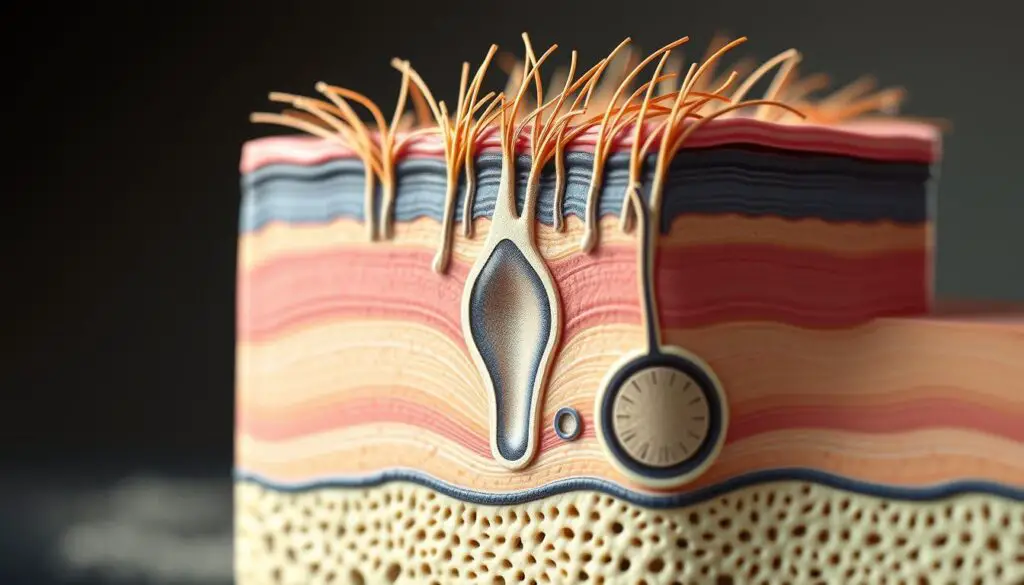
The hair growth cycle is complex, with multiple stages that affect your hair’s health and look. Each strand has its own journey, impacting your hair quality.
The Anagen Phase: The Growth Stage
In the anagen phase, your hair grows actively. This stage lasts 2 to 8 years, with about 90% of your scalp hair in this phase. Key traits include:
- Hair grows about 0.33 millimeters per day
- Potential hair growth of nearly 6 inches per year
- Follicles actively produce new hair cells
The Catagen Phase: Transitioning
The catagen phase is a short transitional period lasting about 2-3 weeks. Hair follicles shrink and detach from the dermal papilla, preparing for the next stage.
The Telogen Phase: Resting and Shedding
In the telogen phase, hair growth stops temporarily. About 10-15% of scalp hairs rest during this 3-month period. Normal hair shedding of 100-150 follicles occurs daily.
| Hair Growth Phase | Duration | Key Characteristics |
|---|---|---|
| Anagen (Growth) | 2-8 years | Active hair production |
| Catagen (Transition) | 2-3 weeks | Follicle shrinkage |
| Telogen (Resting) | 3 months | Hair shedding occurs |
“Understanding your hair’s growth cycle is the first step to achieving healthier, fuller hair.” – Hair Health Expert
Stress, nutrition, and hormonal changes can affect these phases. By understanding these stages, you can better support your hair’s natural growth and address hair loss concerns.
Factors Influencing Hair Growth
Understanding hair growth is more than just looking at the surface. Many complex factors work together to affect your hair’s health. This creates a detailed ecosystem that needs careful attention and holistic care.
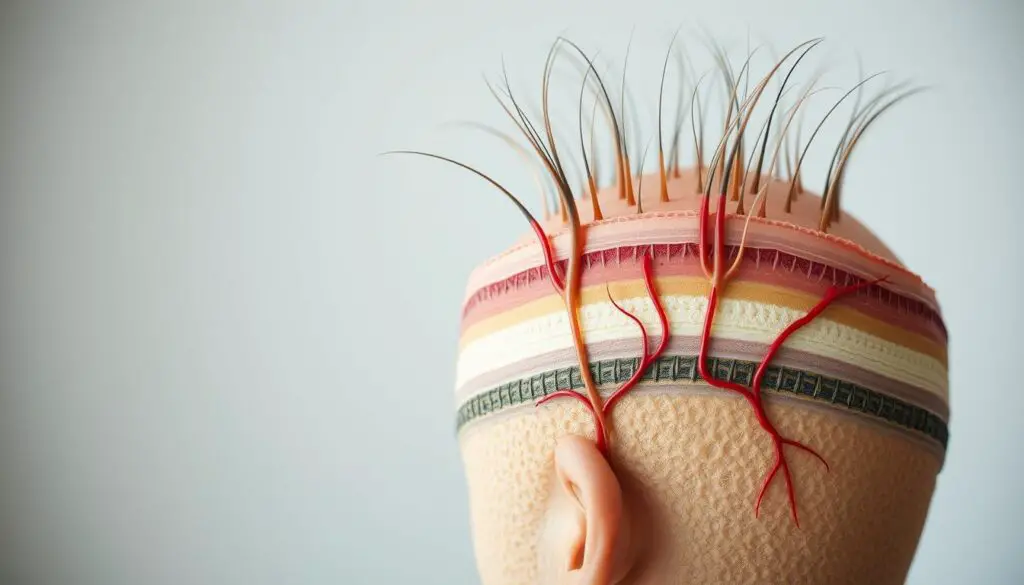
Your hair’s journey is shaped by several key elements. These elements work together to support or hinder growth. Let’s look at the main factors that affect hair health.
Genetic Predisposition
Genetics play a big role in your hair’s traits. Your inherited traits affect:
- Hair thickness
- Growth rate
- Potential for hair loss
- Overall hair texture
Nutritional Impact on Hair Health
Nutrition is key for biotin hair growth. Essential nutrients boost your hair’s strength and growth.
| Nutrient | Hair Growth Benefit |
|---|---|
| Biotin | Promotes keratin production |
| Protein | Builds hair structure |
| Iron | Supports oxygen transportation |
| Zinc | Enhances cell reproduction |
Hormonal Influences
Hormones greatly affect your hair’s growth cycle. Changes in hormonal levels can alter hair density and quality.
“Your hormones are like conductors, orchestrating the complex symphony of hair growth.” – Hair Health Expert
Using essential oils for hair can support natural growth. Understanding these factors helps you make better hair care choices.
Essential Nutrients for Hair Growth
Getting healthy, beautiful hair is more than just using products. What you eat is very important for hair growth and stopping hair loss. Knowing the right foods can make your hair strong and fight DHT.
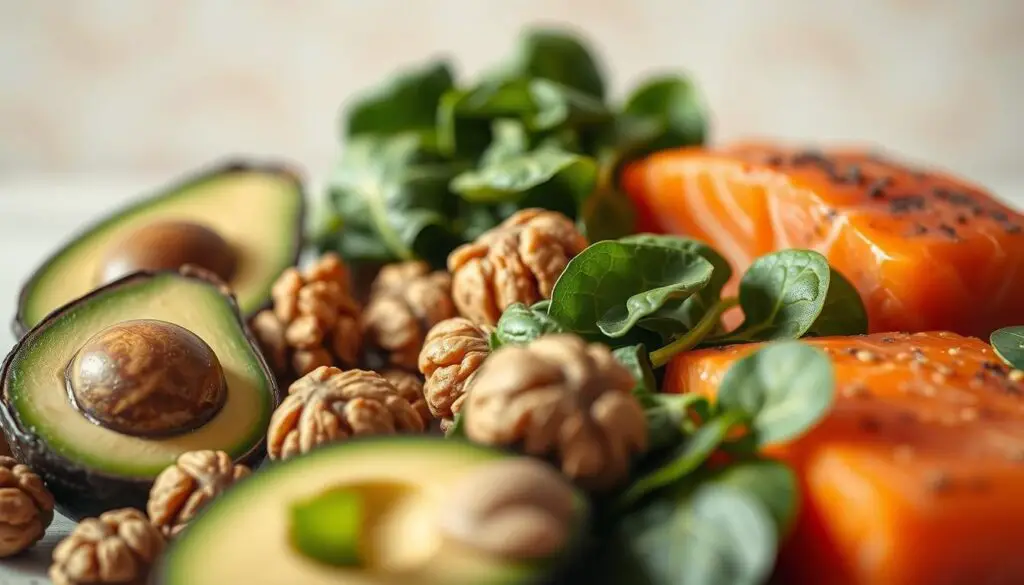
Good nutrition is the base for strong hair. Your body needs certain nutrients to keep your hair strong and fight hair loss.
Protein: The Building Block for Hair
Protein is key for hair growth. Hair is mostly made of keratin, a protein. Without enough protein, your hair gets weak and breaks easily.
- Consume 0.8 grams of protein per kilogram of body weight
- Include lean meats, fish, eggs, and plant-based proteins
- Aim for a palm-sized protein portion at each meal
Vitamins: Key Players in Hair Health
Some vitamins are very important for strong hair. Not having enough can make your hair thin and fall out more.
| Vitamin | Function | Daily Requirement |
|---|---|---|
| Vitamin D | Stimulates hair follicles | 15 mcg |
| Vitamin C | Supports iron absorption | 65-90 mg |
| Vitamin E | Improves scalp circulation | 15 mg |
Minerals You Should Not Ignore
Minerals are also very important for hair health. Iron and zinc help prevent hair loss and keep follicles healthy.
“Nutrition is the most natural DHT blocker and anti-hair fall strategy you can implement.” – Hair Health Experts
- Iron helps deliver oxygen to hair follicles
- Zinc supports protein synthesis
- Recommended daily zinc intake: 8-11 mg
By focusing on these nutrients, you can build a strong base for healthy hair. Remember, eating well is key to keeping your hair healthy.
Effective Hair Care Practices
Keeping your hair healthy is more than just occasional care. It needs consistent attention to prevent split ends and control frizz. Learning the right techniques can greatly improve your hair’s look and health.

Good hair care involves several key steps. These steps work together to keep your hair healthy. Losing 50-100 hair strands a day means gentle care is vital for your hair’s strength and life.
Choosing the Right Shampoo and Conditioner
Choosing the right hair products is crucial for split end repair and frizzy hair control. Here are some important things to consider:
- Match products to your specific hair type
- Look for ingredients that strengthen hair follicles
- Avoid harsh chemicals that strip natural oils
- Consider pH-balanced products (optimal range: 3.67-5.5)
The Importance of Gentle Brushing
Brushing techniques greatly affect hair health. Gentle handling prevents unnecessary breakage and promotes natural shine. Experts suggest:
- Use wide-toothed combs for detangling
- Start from hair ends, moving upward
- Avoid brushing wet hair, which is more vulnerable
Regular Trims for Healthy Growth
Regular trims are key for maintaining hair quality. They help remove damaged ends, stopping split ends from moving up the hair shaft. Most experts recommend trimming every 6-8 weeks for the best hair health.
“Healthy hair starts with proper care and attention to detail.” – Hair Care Professional
By following these effective hair care practices, you’ll be on your way to stronger, more resilient hair. Your hair will look and feel amazing.
Hair Growth Supplements: Do They Work?
Finding the right hair growth supplements can be tough. Many people look for quick fixes for thinning hair. They hope supplements will be the answer. But, it’s important to know if they really work.
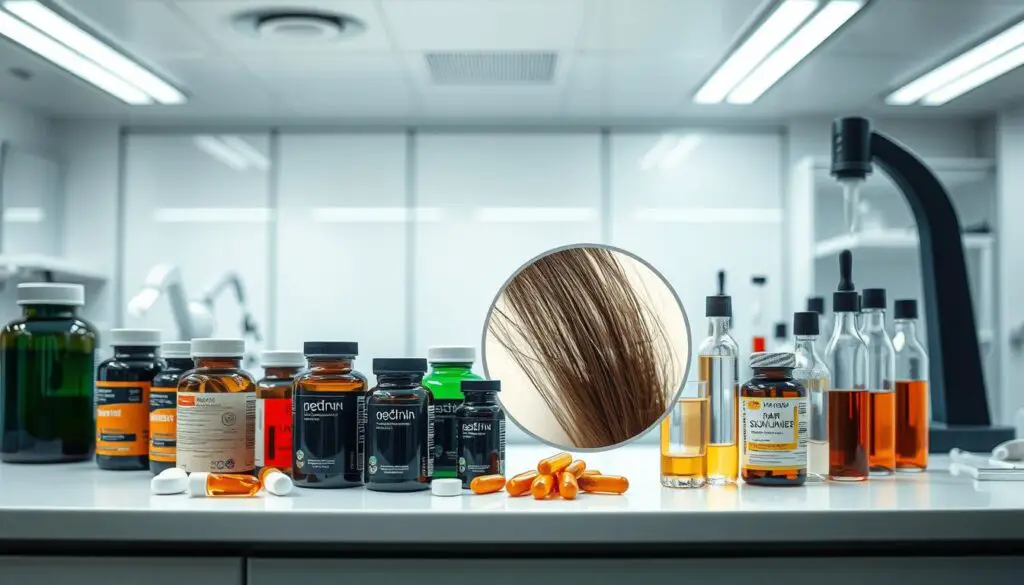
These supplements usually have vitamins, minerals, and plant extracts. They aim to help hair grow healthy. Biotin supplements are popular, but their benefits are debated.
Popular Supplements for Hair Growth
- Biotin (Vitamin B7)
- Zinc
- Vitamin D
- Collagen
- DHT blocker compounds
Scientific Evidence Behind Hair Supplements
Studies on hair supplements show mixed results. A study with 40 women aged 40-65 found Nutrafol helped hair grow over six months. But, only those with certain nutritional gaps saw big improvements.
| Supplement | Potential Benefit | Scientific Support |
|---|---|---|
| Biotin | Hair strength | Limited evidence |
| DHT Blocker | Reduce hair loss | Moderate evidence |
| Zinc | Hair follicle health | Promising research |
Potential Risks and Side Effects
Not all supplements are safe. The FDA doesn’t check them for quality or safety. Possible dangers include:
- Interactions with medicines
- Too much of certain vitamins
- Unexpected side effects
“Supplements should complement, not replace, a balanced diet and professional medical advice.” – Hair Health Expert
Always talk to a doctor before starting supplements. They can help figure out what you need and what might be risky.
Natural Remedies for Hair Growth
Exploring natural ways to grow hair can be exciting. Many look for alternatives to regular hair treatments. They turn to nature’s remedies for healthy hair.
Looking into natural hair oils and essential oils can help. These plant-based solutions are gentle yet effective for hair health.
Essential Oils: Nature’s Powerhouses
Essential oils are getting attention for hair growth. Research shows some are promising:
- Rosemary oil: Improves hair thickness
- Peppermint oil: Stimulates hair follicle growth
- Lavender oil: Supports scalp health
“Nature provides powerful tools for hair growth that can complement traditional treatments.”
Herbal Treatments to Consider
Natural treatments can help your hair grow. Some herbs are worth trying:
| Herb | Potential Benefits |
|---|---|
| Saw Palmetto | Reduces hair fallout by up to 29% |
| Ginseng | Stimulates hair growth phase |
| Onion Juice | Potential hair growth stimulation |
The Benefits of Scalp Massage
Scalp massage is a simple yet effective method. Research shows daily four-minute massages can increase hair thickness. It boosts blood flow and aids in natural hair growth.
When using essential oils, always mix them with a carrier oil. Do a patch test first. Your results may differ, and it’s wise to talk to a healthcare professional before starting any new hair treatment.
Lifestyle Changes to Enhance Hair Growth
Your daily habits are key to healthy hair growth. It’s not just about products; it’s about a holistic approach to wellness. Knowing how lifestyle affects your hair helps you fight hair loss.

Managing Stress for Healthier Hair
Stress can harm your hair’s growth cycle. Chronic stress takes resources from hair production, leading to more hair loss. Stress management is crucial for hair health.
- Practice daily meditation
- Engage in regular deep breathing exercises
- Maintain a consistent sleep schedule
- Consider counseling or therapy
Physical Activity’s Impact on Hair Growth
Exercise is good for your body and hair. It boosts blood flow, delivering nutrients to hair follicles. Aim for 30 minutes of moderate exercise daily.
| Exercise Type | Hair Growth Benefits |
|---|---|
| Cardio | Improves blood circulation |
| Strength Training | Boosts testosterone and growth hormones |
| Yoga | Reduces stress, promotes scalp health |
Sleep: The Foundation of Hair Health
Enough sleep is vital for hair growth. Your body repairs cells, including hair follicles, during sleep. Aim for 7-9 hours of quality sleep each night.
“Your hair’s health is a reflection of your overall wellness.”
By making these lifestyle changes, you support hair growth and reduce loss. Consistency is crucial in any hair loss treatment.
Hormonal Imbalances and Hair Growth
Hormonal changes can greatly affect your hair’s health and growth. Knowing how these changes work helps you keep your hair thick and luscious.
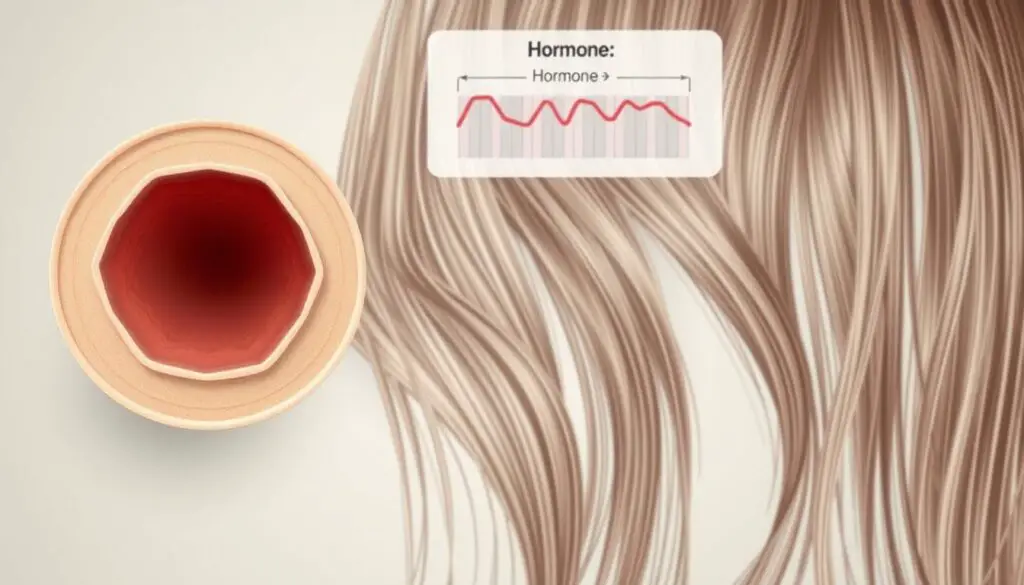
Hormones are key in controlling hair growth cycles. An imbalance can lead to significant hair loss, affecting both men and women at different ages.
Recognizing Signs of Hormonal Issues
Spotting hormonal problems early can stop a lot of hair loss. Look out for these signs:
- Increased hair shedding
- Thinning hair across the scalp
- Changes in hair texture
- Slower hair growth rate
How to Address Hormonal Imbalances
Fixing hormonal imbalances needs a full plan. Using a DHT blocker can help manage hair loss caused by androgens.
| Hormone | Impact on Hair | Potential Solutions |
|---|---|---|
| Testosterone | Can convert to DHT | Natural DHT blockers |
| Thyroid Hormones | Regulate hair growth cycle | Medication and lifestyle changes |
| Estrogen | Supports hair growth | Hormone replacement therapy |
Natural Solutions for Hormone Regulation
Natural ways can help manage hair loss caused by hormones:
- Balanced nutrition
- Stress management techniques
- Regular exercise
- Herbal supplements
“Understanding your body’s hormonal signals is key to maintaining healthy hair growth.” – Dermatology Research Institute
By knowing how hormones affect hair and using the right treatments, you can keep your hair healthy and strong.
Hair Growth Treatments: Professional Options
Professional treatments offer hope for those fighting hair loss. About 50% of women and 80% of men will face hair loss by age 50. This makes advanced treatments key.
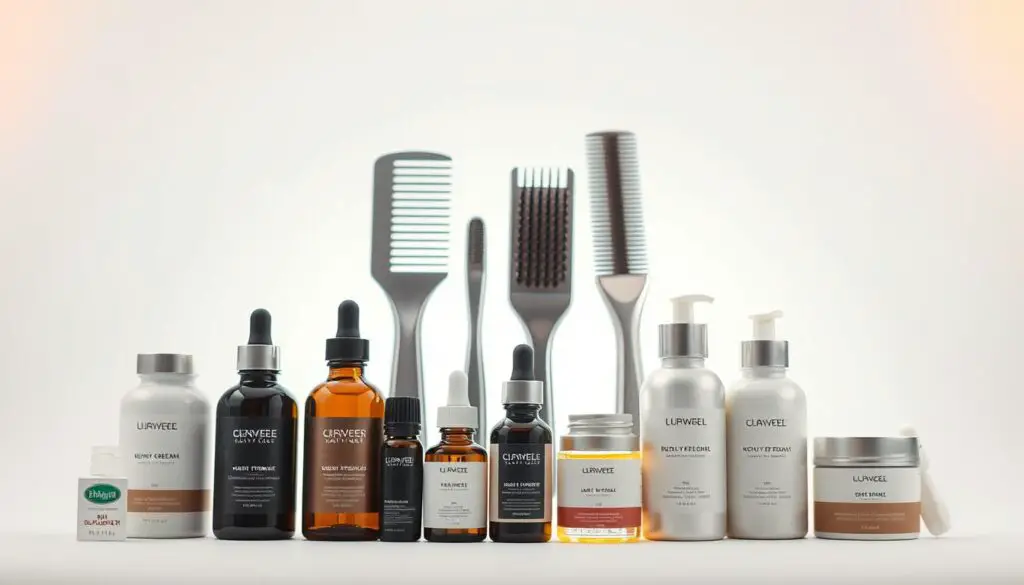
Modern science has brought several professional treatments for hair thinning. These options, including hair thickening serums, target those struggling with hair loss.
Minoxidil: A Popular Choice
Minoxidil is a top FDA-approved treatment for pattern baldness. It’s known for:
- Working for about 40% of users after 6 months
- Being available in topical and foam forms
- Requiring 1-2 mL application twice daily
PRP Therapy: What You Should Know
Platelet-rich plasma (PRP) therapy is a new hair restoration method. It involves:
- 3-4 sessions, one month apart
- Using the patient’s own blood plasma to boost hair growth
- Promising natural hair restoration
Laser Therapy for Hair Restoration
Low-level laser therapy is a non-invasive way to grow hair. Patients can look forward to:
- 15-20 sessions over 3-6 months
- Stimulating hair follicles
- Being less invasive than surgery
| Treatment | Success Rate | Duration |
|---|---|---|
| Minoxidil | 40% | 6 months |
| PRP Therapy | 70% | 3-4 sessions |
| Laser Therapy | 55% | 3-6 months |
“Choosing the right hair loss treatment is a personal journey that requires careful consideration and professional guidance.” – Hair Restoration Experts
Keep in mind, results can differ. Talking to a dermatologist or hair specialist can help find the best treatment for you.
Styling Tips for Thicker-Looking Hair
Getting thicker-looking hair is achievable with the right styling and products. Even if your hair is naturally thin, smart styling can make it look fuller and more vibrant.

Volume-Boosting Haircuts
The right haircut can change how your hair looks. Here are some styles that add volume:
- Pixie cuts with textured layers
- Layered bobs with internal graduation
- Shoulder-length cuts with soft, face-framing layers
Short hair can make your hair look thicker right away. A good stylist can pick a cut that suits your hair type and adds volume.
Effective Use of Hair Products
Using a hair thickening serum can make a big difference. Look for products that add volume without making your hair heavy. Products for frizzy hair that also add volume can make your hair look smoother and fuller.
- Root-lifting sprays before blow-drying
- Volumizing mousses for added body
- Dry shampoos to create instant lift at the roots
Protective Styles to Consider
Styling can also protect your hair while making it look thicker:
- Loose, soft waves add dimension
- Changing your hair part can instantly create volume
- Avoid tight hairstyles that can cause tension
“The right styling approach can transform thin hair into a voluminous, confident look.” – Hair Styling Expert
Pro tip: Always use a protective product when styling with heat. Use the lowest temperature needed to avoid damage. Regular trims and good hair care keep your hair looking thick and healthy.
Myths and Misconceptions About Hair Growth
Learning about hair growth can be tough with all the myths out there. Many people find it hard to tell what’s true and what’s not about hair health. Let’s look at some common myths that might be slowing down your hair growth.
Debunking Common Hair Growth Myths
There are many myths about hair growth that can confuse people. Here are some key misconceptions to know:
- Clipping or shaving hair makes it grow faster or thicker – False. Hair growth is based on genetics, not how you cut it.
- Frequent trimming accelerates hair growth – Incorrect. Trimming just removes split ends and doesn’t change how fast hair grows.
- Ointments and oils dramatically increase hair growth speed – Myth. These products mainly make hair shiny and soft.
Clarifying Misunderstandings About Hair Care
To grow your hair well, you need to know the facts. Did you know your scalp has about 1,000 hairs per square inch? At any time, 85 percent of these hairs are growing.
“Knowledge is the first step toward effective hair growth management.”
The Truth About Hair Growth and Age
Hair growth changes a lot as you get older. Here are some interesting facts:
- Peak hair thickness is around age 20
- Hair grows the fastest between ages 15 and 30
- About 50% of men start losing hair by age 60
- Around 40% of women see hair loss by age 40
Knowing these facts can help you set realistic goals. It can also help you make a hair growth plan that fits your needs.
Tracking Your Hair Growth Progress
Watching your hair grow can be thrilling and enlightening. Seeing how your hair changes helps you find the best ways to grow it longer.
Keeping a Hair Diary
Keeping a detailed hair diary is a great way to track your progress. Here are some tips:
- Take consistent high-quality photographs every 2-3 months
- Measure hair length at regular intervals
- Record nutrition and lifestyle changes
- Note any hair loss treatment interventions
Understanding What Is Normal Growth
Hair grows about half an inch each month on average. Your growth rate can vary based on:
- Genetic predisposition
- Overall health
- Nutrition quality
- Hormonal balance
“Patience and consistent tracking are key to understanding your unique hair growth patterns.”
When to Consult a Professional
Get professional help if you notice:
- Sudden or excessive hair loss
- No visible hair growth after 6 months of dedicated care
- Noticeable changes in hair texture or density
- Scalp conditions affecting hair growth
Tracking your hair growth helps you make better choices for your hair health.
Conclusion: Your Personalized Hair Growth Journey
Your journey to beautiful, healthy hair is unique. It takes dedication, patience, and a plan made just for you. By learning about hair health and using the right strategies, you can make your hair stronger and look better.
Developing a Customized Hair Care Routine
Creating a hair care plan means picking the right products for your hair. Viviscal, the top hair growth supplement in the U.S., helps make your hair thicker and less prone to falling out in 3-6 months. Adding natural hair oil and special care can speed up your hair’s change.
Staying Committed to Your Goals
Being consistent is crucial for hair growth. People start seeing changes in just one month of care. By understanding your hair, using ingredients like collagen and keratin, and taking a holistic approach, you’ll get the best results.
Celebrating Your Hair Growth Achievements
Every bit of progress counts. Whether you’re using supplements, natural treatments, or professional help, each step gets you closer to your hair goals. Stay informed, patient, and proactive to improve your hair and boost your confidence and well-being.
